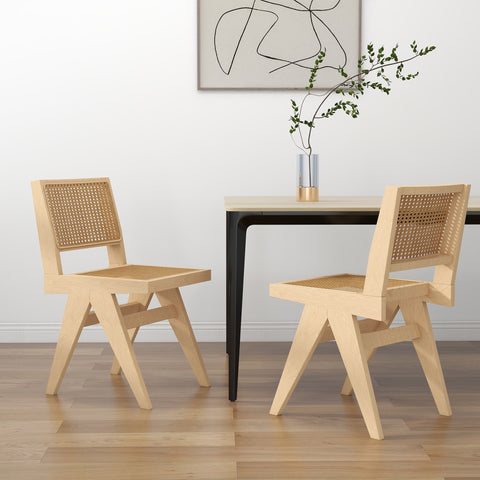How Can Modern Wood Furniture Be Moisture-Proof?
Navigation
- Why Wood Furniture Needs to be Protected from Moisture
- Choosing Moisture-Resistant Wood Types
- Sealing and Staining Techniques
- Proper Furniture Placement
- Regular Maintenance
- Storage Solutions
- Conclusion
Modern wood furniture is beautiful and timeless, but it requires proper maintenance to remain in good condition. Wood is a natural material that is susceptible to damage from moisture, which affects its aesthetic appeal and structural integrity. With the right care and precautions, however, wooden furniture can be moisture-proof and last for years to come. Moisture-proofing wooden furniture starts by selecting the right wood type for the intended purpose. Some hardwoods like teak and mahogany are more resistant to moisture, while softwoods like pine require extra protection. Once the furniture is purchased or built, several finishing techniques can be applied.

Why Wood Furniture Needs to be Protected from Moisture
Wood is porous and hygroscopic, meaning it absorbs water from the atmosphere through small openings in the cells. Excess moisture causes the wood fibers to swell, weakening joints and warping surfaces. Too much moisture over time can also lead to mold, rot, and mildew growth inside the wood. Protecting wood furniture from moisture helps maintain its:
- Aesthetic - Watermarks, stains, swelling, and warping negatively impact the visual appeal of wooden furniture. With proper moisture protection, wood retains its natural luster and intended shape.
- Structural integrity - Excessive swelling from absorbed moisture puts stress on joints, hinges, and fasteners, leading to cracks, splits, and partial or full joint failure over time. Moisture-proofing wood furniture preserves its structural integrity.
- Longevity - Moisture contributes to the decay of the wood material through mold, fungi, and insect infestations. Properly protecting wood from moisture helps it last significantly longer.
Choosing Moisture-Resistant Wood Types
The type of wood used in furniture construction determines how moisture-resistant it will naturally be. Density, oil content, and wood cell structure all play a role. Some of the best options for moisture-resistant wood furniture include:
- Teak - One of the most durable woods, teak is highly resistant to moisture damage due to its natural oils. Teak furniture can last for decades with minimal upkeep.
- Mahogany - The high density and small pores of mahogany make it an excellent choice for moisture-resistant wood furniture. It performs especially well outdoors.
- Cedar - Both Western red and Eastern white cedar contains natural oils that repel moisture. Cedar is a good option for closets, cabinets, and chests.
- Oak - Oak contains tannins that act as natural fungicides, protecting it against molds and rot. Oak furniture can last for many years indoors with proper moisture-proofing.
- Hard maple - Hard maple has a tight grain that makes it less absorbent than other woods. It performs very well for indoor furniture not directly exposed to liquids.
Sealing and Staining Techniques
Sealing and staining techniques are some of the most effective ways to moisture-proof wood furniture after it has been constructed. They create a protective barrier that prevents excess moisture from entering and swelling the wood.
The most common options are:
- Oil sealing - Applying linseed oil, teak oil or mineral oil to wood furniture helps saturate the pores and repel water. The oils must be reapplied periodically.
- Varnish sealing - Varnish finishes like polyurethane create a physical barrier that prevents liquid penetration into the wood. They require reapplication every few years.
- Wax sealing - Waxes like beeswax and carnauba wax fill wood pores and then harden, resisting water penetration. They need to be buffed and reapplied more frequently.
- Water-based sealers - Water-resistant sealers containing acrylic or polyurethane help protect furniture from splashes and light moisture. They must be reapplied at least once a year.
- Outdoor wood stains - Formulated to withstand UV rays and repeated wetting/drying cycles, outdoor wood stains add further moisture protection for outdoor or high-moisture indoor areas.
Proper Furniture Placement
Beyond choosing the right wood and finish, the placement of furniture can significantly impact how well it withstands moisture. Some key placement guidelines:
- Avoid high-humidity areas - Spaces like bathrooms and laundry rooms with high levels of air moisture can cause wood to swell and lead to finish damage.
- Keep off floors - Furniture in direct contact with wet floors is more prone to moisture wicking up through the legs and base. Use felt floor protectors.
- Ventilation - Properly ventilated spaces with airflow help regulate indoor humidity, which is important for preserving wood furniture.
- Distance from heat sources - Excessive heat from objects like fireplaces and heaters can damage wood finishes and cause premature fading of stained wood.
- Away from direct sunlight - While some UV-resistant wood finishes are available, prolonged direct sunlight can cause wood finishes to fade, crack and flake more quickly.
- Use of humidity control - Devices like dehumidifiers can further regulate indoor humidity within the ideal 30-50% range to reduce moisture absorption into the wood.

Regular Maintenance
Even with the right wood, finish, and placement, regular maintenance is important to keep moisture-proofed wood furniture in good condition for as long as possible. Some key maintenance tips include:
- Reapply finishes regularly - Regardless of the finish used, it will eventually wear off with time and exposure. Reapplying the finish helps restore its moisture-resistant properties.
- Wipe up spills immediately - Do not allow liquid to sit on the wood surface for extended periods. Wipe spills up as soon as possible to prevent swelling and staining.
- Dust and polish routinely - A buildup of dust and grime can prevent proper drying of the wood and finishes, trapping moisture. Dust and polish with appropriate products.
- Check for damage - Inspect finishes for cracks, chips, or other damage that could expose bare wood. Sand and reapply finish to problem areas as needed.
- Inspect joints, fasteners, and glue - Check that joints, hinges, and other hardware are still secure. Re-glue or tighten as needed to maintain a moisture barrier.
- Use of humidity control and air purifiers - These appliances can help regulate indoor moisture levels and remove excess moisture from the air.
Storage Solutions
For wood furniture that is not in use, proper storage solutions can help protect it from moisture damage. Options include:
- Sealed plastic bags - Storing wood furniture in thick plastic bags that are fully sealed can help protect it from ambient humidity and moisture. Check bags periodically for leaks.
- Furniture covers - Tailor-made or custom-fit furniture covers made of breathable material like muslin can shield wood surfaces while still allowing it to "breathe."
- Climate-controlled storage - Facilities with temperature and humidity control offer the best environment for long-term storage of valuable wood furniture. Moisture levels can be kept at optimal levels.
- Waterproof wrappings - For furniture that must be stored outdoors, thick waterproof coverings like heavy-duty tarps or shrink wrap can protect the wood from rain and snow.
- Cedar wrap - The natural oils and antimicrobial properties of cedar make it an effective protective wrap for wooden furniture during storage. Change cedar wrappings periodically.
- Dehumidification - The use of moisture-absorbing materials like silica gel packets or pads within storage areas can help keep relative humidity lower and control excess moisture buildup.

Conclusion
In conclusion, with the right choices and maintenance, modern wood furniture can indeed be moisture-proof and last for many years. Selecting durable wood types, thorough sealing and staining, proper placement, and regular upkeep are all essential strategies. Minor damage from moisture can often be remedied easily, while significant swelling and warping may require partial refinishing. But by implementing the right moisture protection practices proactively, wood furniture can remain beautiful and in great condition, enhancing your home or office for a long time to come. With proper care and maintenance, moisture need not spell the end for your beloved wooden furnishings.
Read More
- The Ultimate Guide to Choosing the Perfect Upholstered Office Chair in – Way2Furn
- 4 Expert Cleaning Methods for Upholstered Furniture - Say Goodbye to Stains! – Way2Furn
- Upgrade Your Home Organization with our High-Quality Dining Room Cabinets – Way2Furn
- Choosing the Ideal Solid Wood Dining Chairs - 7 Expert Tips – Way2Furn
- Creating a Warm and Inviting Home with Solid Wood Furniture – Way2Furn






















